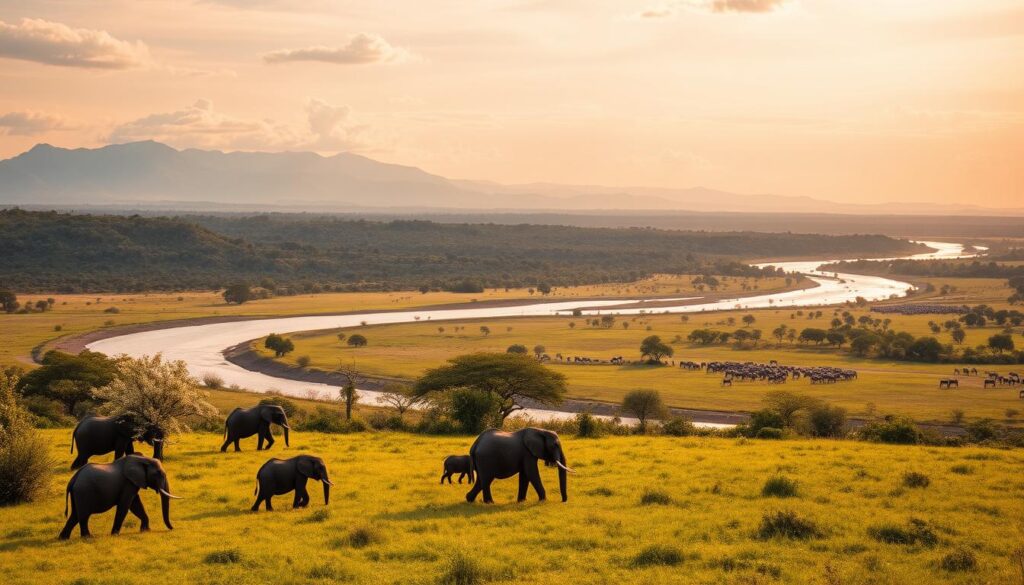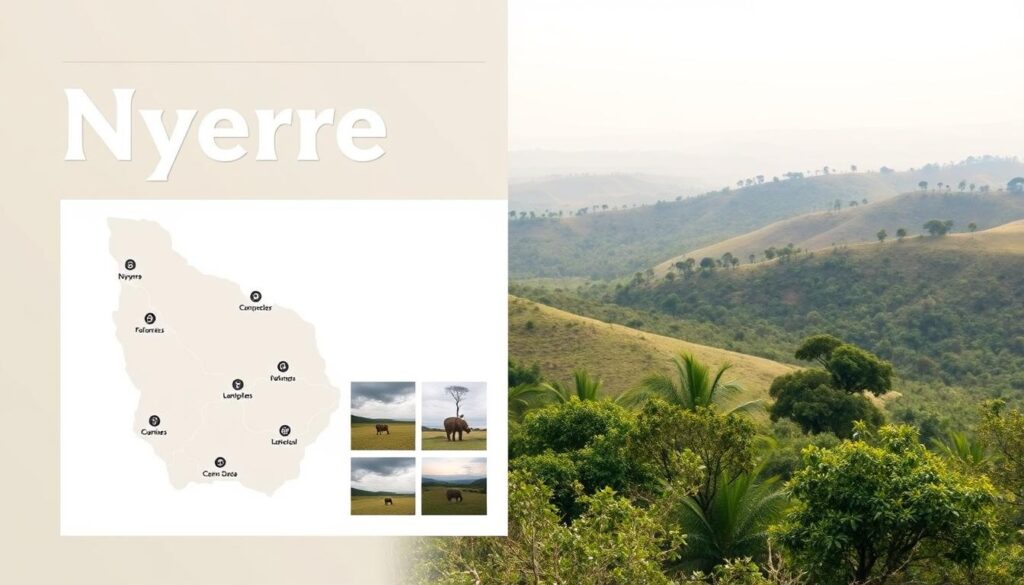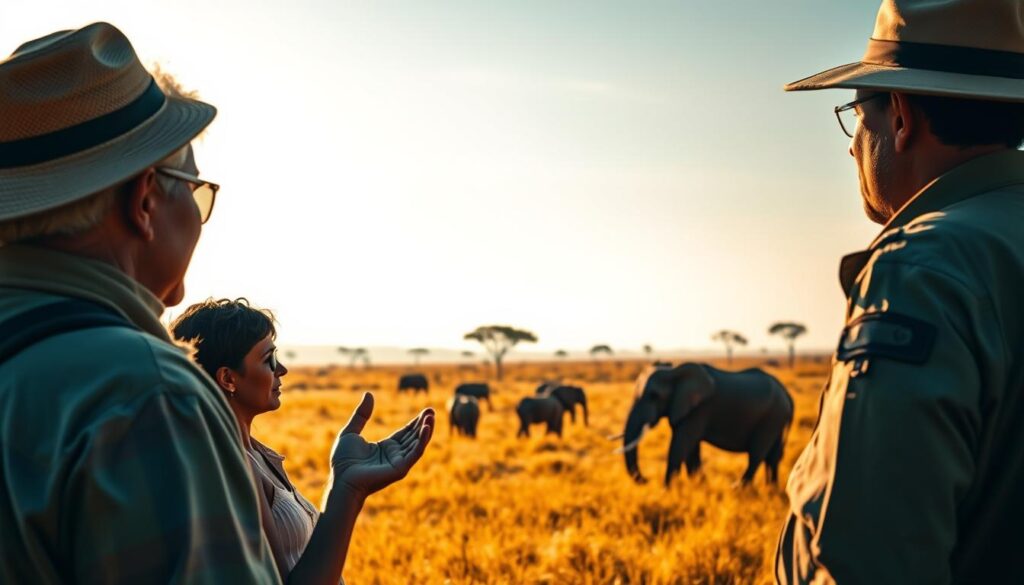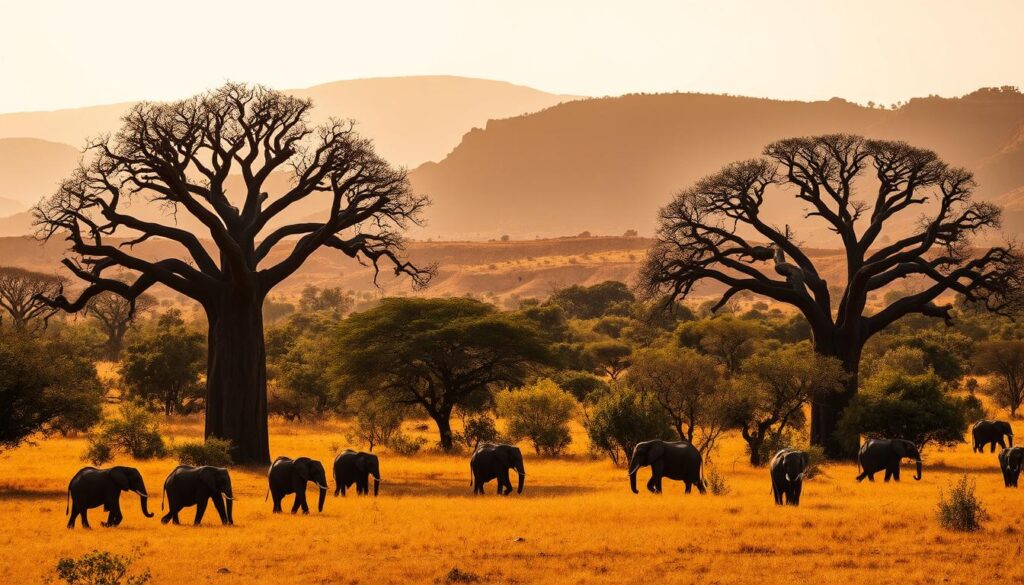Imagine a protected area so vast it could swallow Switzerland whole – yet 93% of travelers can’t name it. Nyerere National Park stretches across 12,000 square miles of Tanzania’s southern wilderness, creating Africa’s largest intact ecosystem. This former game reserve reborn as a national park offers something rare in modern safari culture: complete immersion in nature’s rhythm.
The park’s beating heart is the Rufiji River – a liquid highway connecting oxbow lakes and palm-lined channels. Crocodiles patrol its banks while elephants trumpet from acacia groves. Unlike crowded northern circuits, you’ll share these scenes with more carmine bee-eaters than tourists.
Here, adventure takes primal form. Navigate waterways where hippos surface beside your boat. Track wild dogs through miombo woodlands echoing with fish eagle calls. With landscapes ranging from hot springs to sand rivers, every expedition feels like charting unknown territory.
Key Takeaways
- Largest protected area in Africa – four times bigger than Serengeti
- Untamed wilderness with minimal tourist infrastructure
- Diverse ecosystems anchored by the Rufiji River basin
- Prime location for rare wildlife sightings and river safaris
- Recent UNESCO World Heritage Site designation ensures conservation focus
- Ideal for travelers seeking exclusive, crowd-free experiences
What is unique about Nyerere National Park
https://www.youtube.com/watch?v=sPNoseupy2s&pp=ygUSI3NlbG91c2dhbWVyZXNlcnZl
Your journey through this untamed realm begins where water shapes life itself. The Rufiji River weaves through the landscape like liquid silver, creating a living network of oxbow lakes and palm-fringed channels. These waterways form Africa’s largest river system within any protected area – a biological superhighway sustaining extraordinary biodiversity.
Africa’s Aquatic Powerhouse
Watch sunlight dance on water where 20-foot crocodiles patrol sandbanks unchanged for millennia. Elephants wade through lush marsh islands while yellow-billed storks spear fish in shallow lagoons. This liquid habitat supports over 440 fish species – more than all East African lakes combined.
Predators & Prey in Perfect Balance
Beyond the river’s edge, miombo woodlands teem with life. Witness lion prides stalking buffalo herds three times their size. Spot cheetahs accelerating across open plains – their speed unmatched in the animal kingdom. The park shelters Africa’s healthiest population of painted wolves, with over 1,200 wild dogs hunting in coordinated packs.
| Feature | Rufiji River Area | Miombo Woodlands | Sand River Valleys |
|---|---|---|---|
| Key Species | Hippos, crocodiles, fish eagles | Wild dogs, sable antelope, leopards | Elephants, giraffes, carmine bee-eaters |
| Best Viewing | Boat safaris at dawn | Guided walking tours | Sunset game drives |
| Unique Activity | Riverbank fishing expeditions | Predator tracking experiences | Birdwatching marathons |
With 450 avian species recorded – from tiny sunbirds to massive ground hornbills – binoculars become your most essential safari tool. Conservation efforts here protect both iconic megafauna and vital pollinators, ensuring every creature contributes to the ecosystem’s delicate balance.
Explore the Unique Seasons and Events

Nyerere’s wilderness transforms dramatically with the turning seasons – each revealing distinct rhythms of life. Whether you seek heart-pounding predator encounters or serene moments with nature’s subtler wonders, timing your visit unlocks specialized safari experiences shaped by rainfall patterns and animal migrations.
Dry Season Highlights and Safari Opportunities
From June to October, golden light bathes the savanna as wildlife clusters along the Rufiji River. This prime game viewing window lets you witness elephants sparring at waterholes and lions ambushing thirsty impalas. Clear skies reveal predators patrolling sandbanks, while cooler temperatures make afternoon drives comfortable.
Wet Season Transformations and Birdwatching
November’s rains paint the landscape emerald, attracting over 200 migratory bird species. Flamingos tint lagoons pink, and carmine bee-eaters nest in riverbanks. Though some areas become inaccessible, this season rewards adventurous travelers with rare sightings – like storks hunting frogs in newborn wetlands.
Photographers cherish December’s blooming lilies framing hippo pods, while ecologists marvel at temporary ecosystems forming in seasonal floodplains. No two visits feel identical here – whether you track wild dogs through misty woodlands or glide past crocodile nurseries by boat, each journey writes its own story.
Exciting Things to Do in Nyerere National Park
Unleash your inner explorer through experiences blending raw adventure with untamed landscapes. This vast sanctuary invites you to engage with nature on its terms – from tracking big cats at eye level to drifting past hippo pods in golden light.
Guided Game Drives and Photographic Safaris
Feel your pulse quicken as your 4×4 veers off-road – a rare privilege in Tanzania’s parks. Expert guides navigate acacia-dotted plains where lions stalk buffalo herds. Specialized photographic safaris position you for perfect shots: elephants bathing at dawn or leopards draped over sausage tree branches.
Walking Safaris and Boat Adventures
Tread quietly through miombo woodlands with armed rangers, learning to interpret tracks and bird calls. Multi-day walking expeditions include fly-camping under star-flooded skies. Later, swap boots for boat decks – the Rufiji River reveals crocodile nurseries and hippo highways unseen from land.
| Activity | Best Time | Unique Edge |
|---|---|---|
| Game Drives | June-October | Off-road access for intimate wildlife encounters |
| Walking Safaris | Year-round | Multi-day routes with wilderness camping |
| Boat Cruises | November-April | Access crocodile-rich channels and fishing spots |
| Night Drives | Dry Season | Spot genet cats and hunting hyenas |
Anglers can test skills against tigerfish in river channels, while night drives unveil bushbabies and civets. Every activity here connects you deeper to Africa’s rhythms – without crowds dictating the tempo.
Table of Clarity: Your Guide to Nyerere National Park Attractions

Crafting your Tanzanian safari requires precise planning – let this guide be your compass. From bush-chic lodges to fly-in adventures, we’ve distilled essential details to match your preferences with the park’s wild rhythm.
Comprehensive Overview of Features
| Feature | Options | Key Details |
|---|---|---|
| Accommodation | Luxury lodges to tented camps | 4 service tiers from $350-$1,200/night |
| Access | 3 daily flights from Dar es Salaam | 45-minute transfers to camps |
| Destinations | Ruaha, Katavi, Mahale combos | 7-14 day circuit packages |
| Packages | Photographic to walking safaris | $6,484-$10,087 pp sharing |
Insider Tips for a Smooth Experience
Secure flights 9 months ahead for peak season access – limited airstrips mean early birds win. Many camps close April-May; plan November-March for river-based adventures.
Combine Nyerere with Ruaha’s predator-rich valleys using shared charter flights. Luxury service providers handle border permits – crucial for cross-park itineraries.
- Book December departures for newborn wildlife sightings
- Request sunset river cruises when reserving activities
- Verify if your package includes conservation fees ($83/day)
Remember: Drones and night drives require special permits filed through your service provider 60 days pre-arrival. These necessary legitimate purpose regulations protect both wildlife and your immersive experience.
Safety Tips for Travel in Tanzania

Embarking on a Tanzanian safari demands more than a spirit of adventure—it requires smart preparation. Your journey through wild landscapes becomes unforgettable when paired with thoughtful safety measures. Let’s ensure your focus stays on lion sightings rather than logistical surprises.
Health Precautions and Vaccination Advice
Consult a travel medicine specialist 6-8 weeks before departure. Essential vaccinations include hepatitis A/B, typhoid, and tetanus—crucial defenses against regional health risks. Malaria prophylaxis remains non-negotiable; combine prescribed medication with DEET-based repellents and permethrin-treated clothing.
Pack a personalized medical kit containing prescription drugs, antihistamines, and rehydration salts. Remote park locations mean clinics sit hours away. Comprehensive travel insurance should cover air evacuation—verify policies include $500,000+ emergency coverage.
Practical Travel Logistics and On-Site Safety
All safari activities require licensed guides—self-drive exploration is strictly prohibited. Walking tours employ armed rangers who interpret wildlife behavior while maintaining safe distances. Trust your service provider to handle permits and route planning for seamless access.
| Safety Aspect | Preparation Steps | On-Site Actions |
|---|---|---|
| Health Protection | Vaccinations + malaria prevention | Reapply repellent every 4 hours |
| Navigation | Verify guide credentials | Stay within vehicle during drives |
| Wildlife Encounters | Study animal behavior guides | Maintain 20m distance from large animals |
Dress in neutral colors to avoid startling park residents. Store medications in original containers for customs clearance. Remember: Your preferences shape the experience, but safety protocols ensure you return home with stories rather than scars.
Essential Safari Experiences and Accommodation Options
Your Tanzanian adventure finds its perfect rhythm where luxury meets wilderness. Sleep beneath constellations in eco-conscious camps or unwind in infinity pools overlooking ancient baobabs – every choice connects you to Africa’s soul.
Luxurious Lodges and Authentic Camps
Four tiers of accommodation await within this game reserve. Roho ya Selous leads boutique properties with solar-powered villines perched above river tributaries. Their staff-to-guest ratio of 3:1 ensures your safari wishes become reality before breakfast.
Mid-range options balance comfort with immersion. Think king-sized beds under canvas ceilings, spa treatments using local botanicals, and sundowners served near elephant watering holes. Even budget-conscious travelers find park home comforts – raised platforms keep wildlife at bay while maintaining 360-degree wilderness views.
Tailored Safari Packages for Every Traveler
Custom journeys blend adrenaline with relaxation. A 9-day circuit might pair wild dogs tracking with Zanzibar’s turquoise waters. Premium packages include private guides who decode animal behavior like seasoned storytellers.
| Experience Tier | Key Features | Price Range |
|---|---|---|
| Luxury | Private plunge pools, helicopter transfers | $950-$1,200/night |
| Boutique | Solar-powered camps, conservation focus | $650-$900/night |
| Mid-Range | Pool access, guided walks included | $450-$600/night |
| Adventure | Mobile tented camps, multi-day treks | $350-$425/night |
Flights from Dar Salaam whisk you between ecosystems – land among baobabs by noon, then toast the sunset over Ruaha’s predator-rich valleys. Whether observing animals from your private deck or swapping stories around a bushfire, these experiences redefine connection to nature.
Conclusion
Step beyond typical safari trails into a realm where wilderness writes its own rules. Nyerere National Park delivers Africa’s ultimate uncut adventure – a living theater where elephant herds trumpeting at dusk outnumber tourist vehicles. Here, the Rufiji River pulses through landscapes like liquid lifeblood, sustaining rare species found nowhere else on Earth.
This sanctuary rewards bold travelers with raw, crowd-free encounters. Track predators through golden grasslands by day, then drift past hippo pods as fireflies ignite riverbanks. With more wildlife diversity than northern parks, every moment feels like discovering Earth’s best-kept secret.
Chart your path to destinations Tanzania keeps closest to its heart. Whether navigating palm-fringed channels or sleeping under constellations, Nyerere National Park redefines authentic exploration. Your story in Africa’s largest national park begins where footprints fade and true adventure takes root.
FAQ
Why is the Rufiji River central to Nyerere National Park’s ecosystem?
The Rufiji River fuels life across the park—its winding channels and oxbow lakes sustain massive hippo pods, crocodile populations, and seasonal herds. Boat safaris here reveal elephants bathing and rare birds like Pel’s fishing owl, creating a dynamic water-based wilderness experience.
How does the dry season enhance wildlife viewing opportunities?
From June to October, animals congregate near the Rufiji River and lakes, making predators like lions and African wild dogs easier to spot. Thinning vegetation improves visibility for game drives, while walking safaris let you track wildlife on foot through golden savannahs.
What makes walking safaris in Nyerere National Park unique?
Guided walks immerse you in the untamed bush—you’ll learn to interpret animal tracks, identify medicinal plants, and approach giraffes or zebras silently. This intimate, low-impact activity connects you to the park’s raw beauty while respecting its delicate ecosystems.
Are boat trips safe given the park’s crocodile and hippo populations?
Expert guides navigate the Rufiji River’s channels cautiously, maintaining safe distances from hippo pods and basking crocodiles. Sunset cruises offer serene wildlife viewing, with elephants often spotted drinking at the banks as fish eagles call overhead.
What accommodation options balance comfort and authenticity?
From luxury tented camps with plunge pools overlooking the river to rustic fly-camps for adventurous travelers, lodgings prioritize immersion in nature. Many use solar power and eco-friendly practices, blending modern comforts with the park’s wild ambiance.
How does Nyerere National Park support endangered species conservation?
As part of the Selous-Niassa Wildlife Corridor, the park protects critical habitats for African wild dogs, black rhinos, and elephants. Anti-poaching patrols and community partnerships ensure these species thrive—your visit directly funds these conservation efforts.
Can I combine a safari here with beach destinations like Zanzibar?
Absolutely! Many travelers pair Nyerere’s wilderness adventures with Zanzibar’s beaches. Charter flights from Dar es Salaam or Selous airstrips connect seamlessly to the islands, letting you transition from bushveld to Indian Ocean relaxation in hours.
Reade more articles;
- Kaas Plateau Travel Guide 2026: Best Time to Visit, Bloom Season, How to Reach & FAQs
- What Is the Quirimbas Archipelago Mozambique Known For? Complete Travel & Nature Guide
- Is Angola Safe to Travel in 2025? Your Essential Guide to Health, Crime, and Landmine Safety
- What Animals Live in Bale Mountains Ethiopia? Complete Wildlife Guide
- What to Do in Damaraland — Complete Travel Guide for First-Timers


I am glad to be a visitor of this unadulterated blog! , thankyou for this rare information! .
Thank you for your valuable feedback! It means a lot to us and encourages to write better!
Keep reading our articles and keep posting comments and feedback to make us do better.
I am extremely impressed with your writing skills as well as with the layout on your blog. Is this a paid theme or did you modify it yourself? Either way keep up the nice quality writing, it is rare to see a nice blog like this one nowadays..
Great – I should certainly pronounce, impressed with your web site. I had no trouble navigating through all the tabs and related info ended up being truly easy to do to access. I recently found what I hoped for before you know it at all. Reasonably unusual. Is likely to appreciate it for those who add forums or anything, website theme . a tones way for your client to communicate. Nice task..
Write more, thats all I have to say. Literally, it seems as though you relied on the video to make your point. You definitely know what youre talking about, why waste your intelligence on just posting videos to your site when you could be giving us something enlightening to read?
Good write-up, I am regular visitor of one¦s website, maintain up the nice operate, and It is going to be a regular visitor for a lengthy time.
Very great post. I simply stumbled upon your weblog and wanted to say that I've really enjoyed surfing around your blog posts. In any case I’ll be subscribing for your rss feed and I hope you write once more soon!
Howdy! Would you mind if I share your blog with my zynga group? There's a lot of folks that I think would really enjoy your content. Please let me know. Many thanks
Great post. I was checking constantly this blog and I am impressed! Very useful info particularly the last part 🙂 I care for such info much. I was seeking this certain info for a long time. Thank you and best of luck.
Dead pent content material, Really enjoyed looking through.
Hmm is anyone else having problems with the images on this blog loading? I'm trying to figure out if its a problem on my end or if it's the blog. Any responses would be greatly appreciated.
Very interesting subject, thank you for putting up.
Everything is very open and very clear explanation of issues. was truly information. Your website is very useful. Thanks for sharing.
Real clear website , regards for this post.